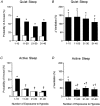Repetitive hypoxia rapidly depresses cardio-respiratory responses during active sleep but not quiet sleep in the newborn lamb
- PMID: 10457072
- PMCID: PMC2269508
- DOI: 10.1111/j.1469-7793.1999.0571m.x
Repetitive hypoxia rapidly depresses cardio-respiratory responses during active sleep but not quiet sleep in the newborn lamb
Abstract
1. Arousal from sleep is an important protective response to hypoxia that becomes rapidly depressed in active sleep (AS) when hypoxia is repeated. This study questioned whether there might also be selective depression of cardio-respiratory responses to hypoxia during AS. 2. Nine newborn lambs (7-22 days of age) were studied over three successive nights. The first and third nights were baseline studies (inspired oxygen fraction, Fi,O2 = 0.21). During the second night, during every epoch of sleep, lambs were exposed to 60 s episodes of isocapnic hypoxia (Fi,O2 = 0.10). 3. During quiet sleep (QS), the probability of arousal in hypoxia exceeded the probability of spontaneous arousal (P < 0.001) throughout repeated exposures to hypoxia. Similarly, there were persisting increases in ventilation (135 +/- 25 %), blood pressure (3 +/- 1 %) and heart rate (3 +/- 1 %). 4. By contrast, rapid depression of all responses occurred during repetitive hypoxia in AS. Thus, the probability of arousal in hypoxia exceeded the probability of spontaneous arousal during the first 10 hypoxia exposures (P < 0.001) but not thereafter. Similarly, during the first 10 exposures to hypoxia, the changes in ventilation (88 +/- 15 %) and blood pressure (5 +/- 1 %) were greater than subsequent responses (P < 0.05). 5. We conclude that, when repeated, hypoxia rapidly becomes ineffective in stimulating protective arousal, ventilatory and blood pressure responses in AS, but not in QS. Selective depression of responses during AS may render the newborn particularly vulnerable to hypoxia in this state.
Figures


Similar articles
-
The effects of repeated exposure to hypercapnia on arousal and cardiorespiratory responses during sleep in lambs.J Physiol. 2007 Jul 1;582(Pt 1):369-78. doi: 10.1113/jphysiol.2007.132415. Epub 2007 Apr 19. J Physiol. 2007. PMID: 17446220 Free PMC article.
-
Repetitive hypoxia rapidly depresses arousal from active sleep in newborn lambs.J Physiol. 1998 Jul 15;510 ( Pt 2)(Pt 2):651-9. doi: 10.1111/j.1469-7793.1998.651bk.x. J Physiol. 1998. PMID: 9706012 Free PMC article.
-
Arousal and cardiorespiratory responses to airflow obstruction in sleeping lambs: effects of sleep state, age, and repeated obstruction.Sleep. 1997 Sep;20(9):693-701. doi: 10.1093/sleep/20.9.693. Sleep. 1997. PMID: 9406319
-
Postnatal development of ventilatory and arousal responses to hypoxia in human infants.Respir Physiol Neurobiol. 2005 Nov 15;149(1-3):257-71. doi: 10.1016/j.resp.2005.03.006. Respir Physiol Neurobiol. 2005. PMID: 15876558 Review.
-
The circulation in sleep in newborn lambs.Aust Paediatr J. 1986;22 Suppl 1:71-4. Aust Paediatr J. 1986. PMID: 3539082 Review.
Cited by
-
Reversible blunting of arousal from sleep in response to intermittent hypoxia in the developing rat.J Appl Physiol (1985). 2010 Dec;109(6):1686-96. doi: 10.1152/japplphysiol.00076.2010. Epub 2010 Oct 7. J Appl Physiol (1985). 2010. PMID: 20930126 Free PMC article.
-
Arousal from sleep in response to intermittent hypoxia in rat pups is modulated by medullary raphe GABAergic mechanisms.Am J Physiol Regul Integr Comp Physiol. 2012 Mar 1;302(5):R551-60. doi: 10.1152/ajpregu.00506.2011. Epub 2011 Dec 7. Am J Physiol Regul Integr Comp Physiol. 2012. PMID: 22160541 Free PMC article.
-
Impaired arousal in rat pups with prenatal alcohol exposure is modulated by GABAergic mechanisms.Physiol Rep. 2015 Jun;3(6):e12424. doi: 10.14814/phy2.12424. Physiol Rep. 2015. PMID: 26059034 Free PMC article.
-
The effects of repeated exposure to hypercapnia on arousal and cardiorespiratory responses during sleep in lambs.J Physiol. 2007 Jul 1;582(Pt 1):369-78. doi: 10.1113/jphysiol.2007.132415. Epub 2007 Apr 19. J Physiol. 2007. PMID: 17446220 Free PMC article.
-
Obstructive sleep apnea presenting as recurrent cardiopulmonary arrest.Sleep Breath. 2009 Mar;13(1):89-92. doi: 10.1007/s11325-008-0209-3. Epub 2008 Aug 6. Sleep Breath. 2009. PMID: 18682999
References
-
- Berthon-Jones M, Sullivan CE. Ventilatory and arousal responses to hypoxia in sleeping humans. American Review of Respiratory Disease. 1982;125:632–639. - PubMed
-
- Bowes G, Woolf GM, Sullivan CE, Phillipson EA. Effect of sleep fragmentation on ventilatory and arousal responses of sleeping dogs to respiratory stimuli. American Review of Respiratory Disease. 1980;122:899–908. - PubMed
-
- Brooks D, Horner RL, Kimoff J, Kozar LF, Render-Teixeira CL, Phillipson EA. Effect of obstructive sleep apnea versus sleep fragmentation on responses to airway occlusion. American Journal of Respiratory and Critical Care Medicine. 1997;155:1609–1617. - PubMed
-
- Campbell AJ, Bolton DPG, Taylor BJ, Sayers RM. Responses to an increasing asphyxia in infants: effects of age and sleep state. Respiration Physiology. 1998;112:51–58. - PubMed
Publication types
MeSH terms
LinkOut - more resources
Full Text Sources
Other Literature Sources
Research Materials

